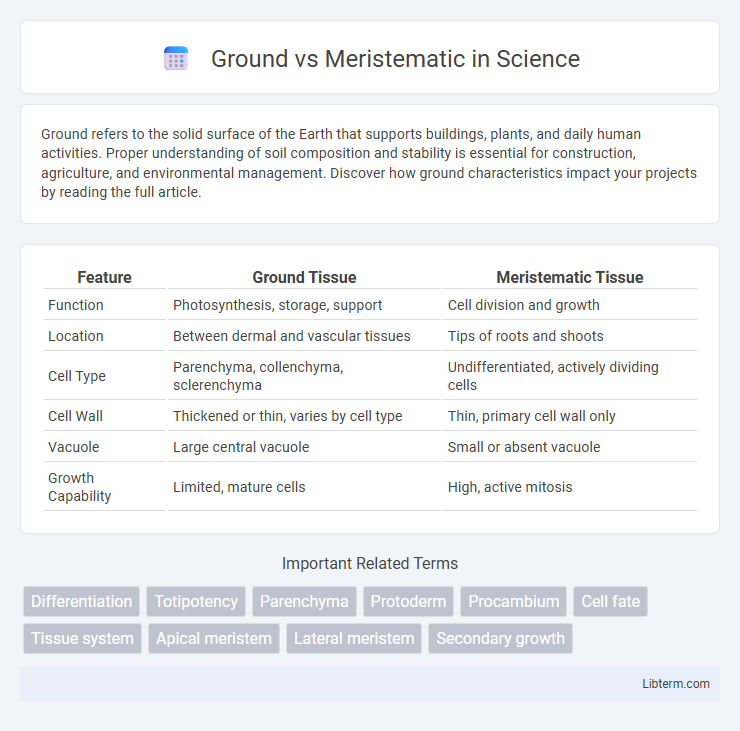Ground refers to the solid surface of the Earth that supports buildings, plants, and daily human activities. Proper understanding of soil composition and stability is essential for construction, agriculture, and environmental management. Discover how ground characteristics impact your projects by reading the full article.
Table of Comparison
| Feature | Ground Tissue | Meristematic Tissue |
|---|---|---|
| Function | Photosynthesis, storage, support | Cell division and growth |
| Location | Between dermal and vascular tissues | Tips of roots and shoots |
| Cell Type | Parenchyma, collenchyma, sclerenchyma | Undifferentiated, actively dividing cells |
| Cell Wall | Thickened or thin, varies by cell type | Thin, primary cell wall only |
| Vacuole | Large central vacuole | Small or absent vacuole |
| Growth Capability | Limited, mature cells | High, active mitosis |
Introduction to Plant Tissues
Ground tissue in plants primarily functions in photosynthesis, storage, and support, consisting of parenchyma, collenchyma, and sclerenchyma cells. Meristematic tissue contains actively dividing cells responsible for plant growth, found in regions such as the apical meristems of shoots and roots. These two tissue types differ fundamentally in cell differentiation; ground tissue cells are mature and specialized, whereas meristematic cells are undifferentiated and totipotent.
Overview of Ground Tissue
Ground tissue, primarily composed of parenchyma, collenchyma, and sclerenchyma cells, functions in photosynthesis, storage, and structural support within plants. It occupies the majority of the plant body, situated between the epidermis and vascular tissues, and plays a crucial role in metabolic processes and mechanical strength. Unlike meristematic tissue responsible for growth through cell division, ground tissue consists of mature cells specialized in various physiological functions.
Overview of Meristematic Tissue
Meristematic tissue consists of undifferentiated cells capable of continuous division, driving plant growth at root and shoot tips. These cells are small, densely packed, with thin walls and prominent nuclei, specialized for generating new tissues. Meristematic regions enable plants to increase in length (apical meristems) and girth (lateral meristems), distinguishing them functionally from ground tissue, which supports and stores nutrients.
Key Differences in Structure
Ground tissue consists of parenchyma, collenchyma, and sclerenchyma cells, characterized by varied cell wall thickness and functions such as storage, support, and photosynthesis. Meristematic tissue is composed of small, densely packed cells with thin primary walls, lacking large vacuoles, enabling continuous cell division and growth. The structural distinction lies in meristematic cells being undifferentiated and actively dividing, while ground tissue cells are differentiated with specialized roles in the plant body.
Functional Roles in Plant Growth
Ground tissue in plants primarily provides structural support, stores nutrients, and facilitates photosynthesis, contributing to overall plant growth and development. Meristematic tissue consists of actively dividing cells responsible for producing new tissues, enabling continuous growth in length (apical meristems) and girth (lateral meristems). The functional distinction lies in ground tissue's role in maintaining and sustaining mature plant functions, while meristematic tissue drives the generation of new cells essential for growth and regeneration.
Locations Within the Plant
Ground tissue is primarily found between the vascular and dermal tissues, forming the bulk of the plant's internal structure in stems, roots, and leaves, where it performs photosynthesis, storage, and support functions. Meristematic tissue is located in specific growth regions such as apical meristems at root and shoot tips, and lateral meristems like the vascular cambium, driving cell division and plant growth. The spatial distribution of ground and meristematic tissues reflects their distinct roles in plant development and physiology.
Cell Types and Characteristics
Ground tissue in plants primarily consists of parenchyma, collenchyma, and sclerenchyma cells, each specialized for functions like photosynthesis, support, and protection with distinctive cell wall thickness and structure. Meristematic tissue contains undifferentiated, actively dividing cells with dense cytoplasm and large nuclei, responsible for primary growth and generating various specialized tissues. Unlike the differentiated cells in ground tissue, meristematic cells lack vacuoles and have thin cell walls, enabling continuous cell division and development.
Contribution to Plant Development
Ground tissue provides structural support, stores nutrients, and facilitates photosynthesis essential for plant growth, while meristematic tissue is responsible for continuous cell division and growth, enabling the formation of new organs and tissues. Meristematic cells contribute to primary and secondary growth by generating differentiated cells that form ground, vascular, and dermal tissues. The interaction between ground and meristematic tissues ensures the plant's overall development, adaptation, and regeneration.
Adaptations and Specializations
Ground tissue in plants specializes in storage, photosynthesis, and structural support, adapting with parenchyma cells that contain chloroplasts for energy conversion and collenchyma cells providing flexible support. Meristematic tissue, composed of undifferentiated cells, exhibits specialization for continuous cell division and growth, enabling the formation of new organs and tissues. Adaptations in meristematic cells include dense cytoplasm and thin walls, facilitating rapid mitosis and differentiation into various specialized cell types.
Summary: Ground vs Meristematic
Ground tissue in plants primarily consists of parenchyma, collenchyma, and sclerenchyma cells, providing support, storage, and photosynthesis functions. Meristematic tissue, found in regions like apical and lateral meristems, is responsible for active cell division and growth, producing new cells that differentiate into various tissues. While ground tissue performs specialized roles in mature plant organs, meristematic tissue maintains the plant's growth potential and regenerates tissues throughout its life cycle.
Ground Infographic

 libterm.com
libterm.com